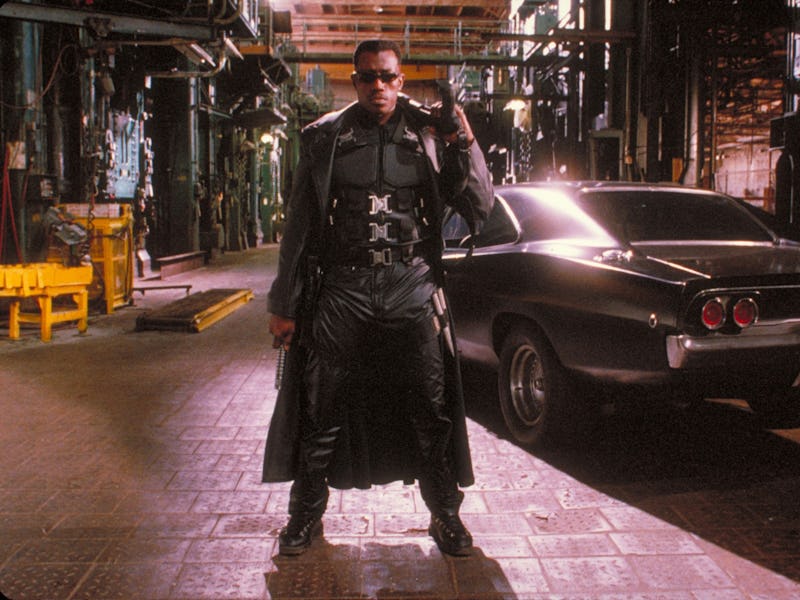Return to the ‘90s to Remind Yourself What a Good Marvel Movie Looks Like
As the MCU flails, Marvel could do worse than look back on one of its most intense films.

In the late-’90s, a leather duster and shades-sporting action hero proved superhero movies could still work. Bolstered by impressively choreographed action sequences, a horror-tinged tone, and a distinct urban grunge, this anti-hero and his vampire-hunting exploits proved the perfect antidote to the increasingly inane comic book adaptations that abounded by the mid-’90s. Now, 25 years after he arrived on-screen, this mysterious figure might offer some insight into how superhero movies can find their way again.
In the summer of 1998, a year after Batman & Robin almost murdered the comic book movie, Blade presented an unapologetically dark tone and brutal protagonist played with effortless cool by Wesley Snipes. Often cited as an overlooked comic book gem, Blade was Marvel’s first modest theatrical hit, coming before the X-Men movies and Sam Raimi’s Spiderman trilogy, and making a worldwide total of $131 million.
That may not seem like much compared to the billion-dollar superhero blockbusters of today. But at the time, Marvel was coming off a bankruptcy filing, while its biggest cinematic effort had been 1986’s Howard the Duck. The company followed that massive bomb with a series of paltry offerings in the form of The Punisher (1989), the direct-to-video Captain America (1990), and the still unreleased Fantastic Four (1994).
With Blade, however, Marvel saw the first hint of future box office success. The character was a little-known entity created as a straightforward vampire hunter by Marv Wolfman and Gene Colan for issue #10 of The Tomb of Dracula in 1972. The movie adaptation, written by David S. Goyer of Batman Begins fame, reinvented Blade as the Daywalker, a half-human, half-vampire hybrid imbued with all the strength of the latter, but the former’s ability to withstand daylight.
The film follows Blade on his quest to take down enterprising vamp Deacon Frost (Steven Dorff) before he can resurrect the blood god, La Magra, and turn the global population into one giant blood-sucking mass. Directed by Steven Norrington (The League of Extraordinary Gentlemen), Blade remains a sleek R-rated action film set in a world that, while fantastical, feels viscerally real. The opening vampire blood rave fight is a classic sequence featuring one of the coolest character introductions in film history, as the carnal exuberance of the vamp revelers is immediately disrupted by Blade’s slick, stoic energy.
Blade’s gruesome introduction is one of the best in superhero history.
When Blade debuted, Kevin Feige’s most recent credit was as a production assistant on You’ve Got Mail. He would, of course, go on to oversee the rise of Marvel’s now omnipresent cinematic universe. But in recent years, that rise hit a plateau. A combination of superhero fatigue, overuse of rushed CGI, poor script-writing, and Marvel’s oversaturation of the streaming market has led to a malaise among audiences that won’t be easily overcome.
The apparent decline of the Marvel Cinematic Universe was further solidified by the lukewarm response to Secret Invasion, which should have been a huge event but proved a pale pastiche of a John le Carré thriller. Now, just as it helped revive a then-flailing superhero genre in the ‘90s, Blade might hold some of the answers to Marvel’s modern quandary.
MCU films have always tried to balance drama with quips and crowd-pleasing moments. But David Goyer and Steven Norrington demonstrated how to make something simultaneously serious and funny, punctuating the doom-laden tone of Blade with comedic moments that arose naturally from the story. For instance, Snipes’ vampire hunter repeatedly injures Donal Logue’s vamp lackey Quinn in increasingly violent ways, making for a grotesque yet funny running gag.
Snipes’ sheer badassery carries much of the film, but it helps that the world around him feels real.
Elsewhere, the environments of Blade feel tactile in a way modern CGI can’t match. With its degraded industrial environs and steely, sterile vampire hideouts, Norrington’s film calls to mind Christopher Nolan’s comments on Blade Runner. Speaking to the Directors Guild, Nolan extolled “that feeling that there was this whole world outside the frame of the scene,” adding that “every film should have its own world, a logic and feel to it that expands beyond the exact image that the audience is seeing.” Aside from the immersive CGI worlds of Guardians of the Galaxy Vol. 3, Marvel’s recent movies haven’t accomplished anything like this.
Kevin Feige has long championed the MCU’s ability to draw from its vast catalog of stories while switching genres with each project, but Secret Invasion is a perfect example of how trying to do everything often amounts to nothing much at all. And with a new Blade movie in Marvel’s future, things aren’t looking all that auspicious for its debut.
It’s telling that 1998’s Blade couldn’t exist within the modern MCU, not only because of its R rating but because it was a singular vision with a distinct tone and confident stylistic sensibility. On the film’s 25th anniversary, Marvel would do well to join all of us in revisiting its gory resplendence.